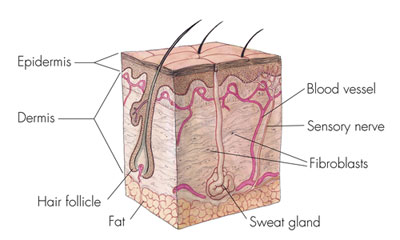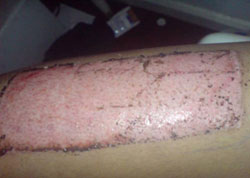

What are the functions of skin?
Skin is the largest organ in the body, a highly dynamic network of cells, nerves, and blood vessels. Skin does many things, including:
- Protects us from the cold, heat, and microorganisms
- Preserves fluid balance
- Controls body temperature
- Senses the outside world
- Helps prevent and fight disease
What is artificial skin?
Thirty years ago, National Institutes of Health-funded burn surgeons determined that badly burned skin should be removed as quickly as possible, followed by immediate and permanent replacement of the lost skin. This seemingly simple idea ultimately became standard practice for treating major burn injuries and led to the development of an artificial skin system called Integra® Dermal Regeneration Template™.
Why is artificial skin needed?
When skin is damaged or lost due to severe injury or burns, bacteria and other microorganisms have easy access to warm, nutrient-rich body fluids. Loss of these vital fluids can lead to shock. Also known as “circulatory collapse,” shock can occur when the blood pressure in a person’s arteries is too low to maintain an adequate supply of blood to organs and tissues. To treat a severe burn, surgeons first remove the burned skin and then quickly cover the underlying tissue, usually with a combination of laboratory-grown skin cells and artificial skin.
How does artificial skin work?
After removing burn-damaged skin, surgeons blanket a wound with a covering like Integra®, then apply a skin graft on top of this biomaterial to encourage the growth of new skin to close the wound. Ideally, surgeons obtain skin grafts from an unburned area of skin elsewhere on the body. But when the burn is severe and covers 80 to 90 percent of a person’s body surface, there is not enough skin to use for this purpose.

What is a skin graft?
There are two types of skin grafts. An autologous skin graft transfers skin from one part of the body to another. In contrast, an allograft transfers skin from another person, sometimes even a cadaver. Allografts offer only temporary cover, as they are quickly rejected by a person’s immune system.
How are skin grafts made?
New epidermal skin can be produced by taking cells from a non-burned epidermal layer of skin, growing them into large sheets of cells in a laboratory, then placing the cell sheets on top of Integra®. Scientists do not yet know how to grow the lower, dermal layer of skin in the lab.
What is Integra®?
Integra® is an artificial substance that contains no living components. It is not designed to be a replacement skin. Rather, Integra® supplies a protective covering and a pliable scaffold onto which a person’s own skin cells can regenerate the lower, dermal layer of skin destroyed by burn.
What is Integra® made of?
Integra® consists of two layers, just like living skin. The bottom layer, which is designed to regenerate the lower layer of real skin, is composed of a matrix of interwoven bovine collagen (a fibrous cow protein) and a sticky carbohydrate (sugar) molecule called glycosaminoglycan that mimics the fibrous pattern of the bottom layer of skin. This matrix then sticks to a temporary upper layer: a medical-grade, flexible silicon sheet that mimics the top, epidermal layer of skin. Integra® looks somewhat like translucent plastic wrap.
How does artificial skin help a burn victim?
After first removing tissue destroyed by a severe burn, a burn surgeon drapes Integra® over a wounded area of skin and leaves it there for 2 to 4 weeks, during which time the burn victim’s own cells climb onto the matrix and grow a new dermis. Surgeons then remove the top layer of Integra® and apply a very thin sheet of that person’s own epithelial cells. Over time, a normal epidermis (except for the absence of hair follicles) is reconstructed from these cells.
Who makes Integra®?
Integra® was originally licensed, tested, and produced by Marion Laboratories of Kansas City, Missouri. It is now manufactured and sold by Integra LifeSciences Corporation of Plainsboro, New Jersey.
Content created July 2008
